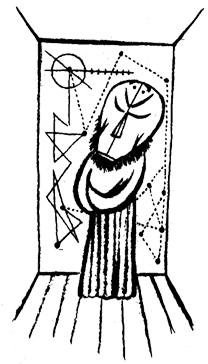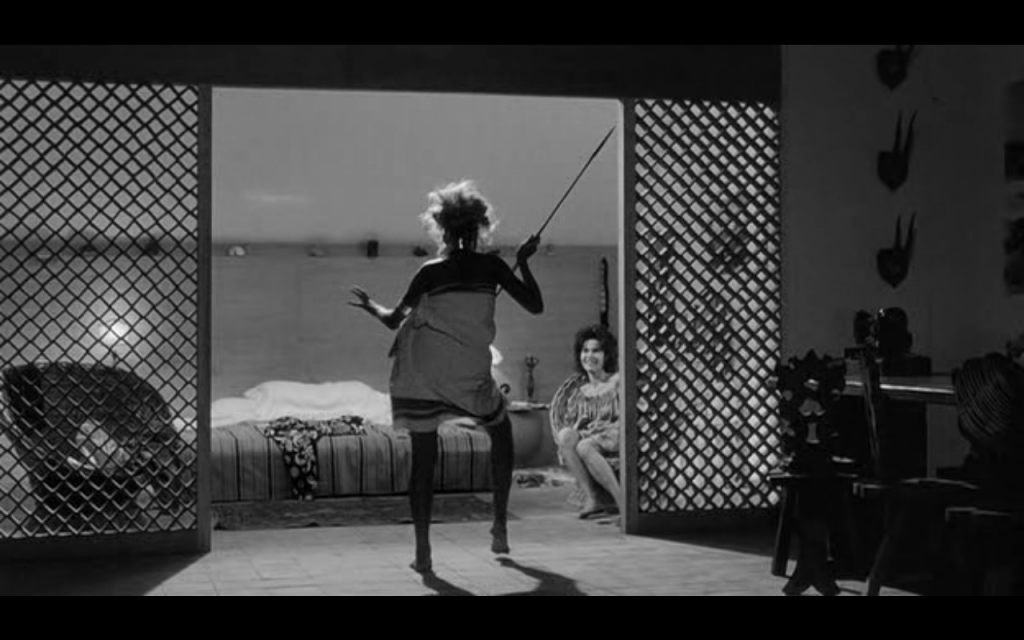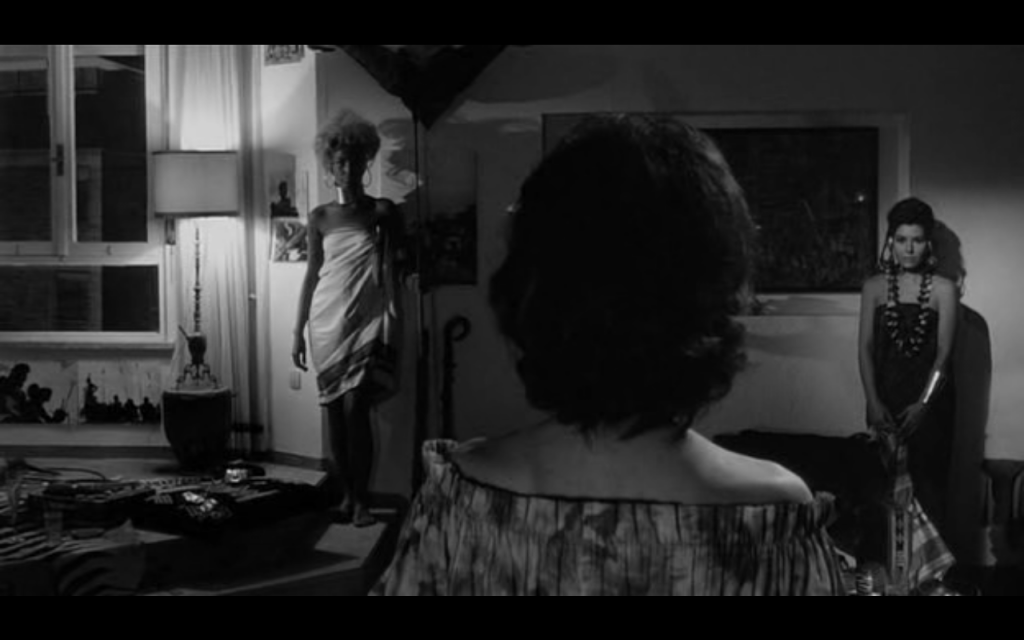February 10, 2011
Kartina Richardson
Race in Film: L’eclisse
In Michelangelo Antonioni’s 1962 film L’eclisse (Eclipse), time is the enemy. For this reason the chronically depressed will understand it implicitly. They will know that a fan turning left to right makes all the more stagnant the air in a room. They will understand that no part of that room, no corner or cushion, can provide relief from the realization that every approaching minute is opportunity for life to prove itself meaningless.
Do you not hear the constant victory,
in the human footrace
of time, slow as fire,
sure, and thick and Herculean
accumulating its volume and adding its sad fiber?– Pablo Neruda (Cold Work)
Faced with this pointless existence, the only thing to do is roam listlessly about, picking things up and putting things down.
This is what Vittoria does.
Played by Monica Vitti, Vittoria falls out of love with lover Riccardo and into an affair with stock broker Piero, another relationship doomed to dissatisfy. In between (and during) she wanders about the urban landscape of Rome.
L’eclisse is a modern movie. Its allegiance to an early sixties modernism and aesthetic is declared in its opening titles. It is a movie of hard lines and clean surfaces. A movie about those who have climbed up, out of nature to build lives high above its savagery. As Katharine Hepburn says in the African Queen:
“Nature, Mr. Allnut is what we are put in this world to rise above.â€
However, for all its convenience the industrialized world is soulless. In our frenzy to escape/crush nature and savagery, we have trivialized, perhaps even demonized, a belief in what Pasolini called the “great epic and mythological dimension of life”. But without symbols and ceremony, without an acknowledgment of the spiritual, human existence is shapeless. Panicked by this formlessness, we flail to find meaning. These tiny imperceptible thrashings manifest as a lifetime long melancholy.
This is a panic Antonioni explores by forcing viewers to apply meaning themselves. Many scenes in the film, as in all Antonioni films, begin with a purposefully disorienting shot: A closeup of raised plaster on a wall for example. This image could be many things: a mountain range viewed from above or, just as easily, peaked frosting on a birthday cake.
We don’t understand that it’s a wall until something tells us it is. Until a hand brushes across it and nails a picture on its surface. The hand, the frame, its size, angle to the surface, and movement gives meaning to the shape that was previously a mystery. The opening shot of L’eclisse frames a white shape on top of some books.
This means nothing until the shape moves. The camera reveals it to be that of a man’s arm. Now it means many things. It tells us about this man. This miserable, miserable man.
Things of course do not have meaning until we give them significance. We create the significance of the world around us. But in a sanitized world that has been scrubbed of spiritual meaning, when there isn’t even physical labor to justify our actions concretely, what is the bourgeoisie to do?
For Vittoria, the answer is clear:
Dress up in blackface and “play negroâ€.
United in sleeplessness Vittoria and neighbor Anita visit the apartment of Marta, a fellow insomniac living across the courtyard. Marta, a white woman, has just returned to Rome from Kenya, the country of her birth and childhood. The walls of the apartment are covered in photographs of the Kenyan countryside and Masai* men and women. African statues, spears and artwork stand on tables and in every corner.
But despite this grand show of Kenyan love, Marta has no real identity. As an Italian born and raised in Kenya her presence is a product of colonialism and as such, is rightly resented by the true inhabitants of the country she loves (a country in political upheaval). This then calls into question the legitimacy of her right to an African identity. Still, it is Kenya and not Italy that Marta loves and knows as home. She uses Kenyan art and imagery as a shield to deflect suspicions that she is any less an authentic African than black Africans. That she is not an outsider. So strong is her allegiance to Kenya, so strong is her desire to solidify her Kenyaness that she returned to the country to give birth to her child. And all this adoration despite her disgust with black Africans. One that barely masks an intense envy for belonging.
Marta: The six million negros want to throw out the 60,000 whites. We’re lucky they’re still in trees and have barely lost their tails or they’d have already thrown us out.â€
Anita: About time too
Marta: I’ll say one thing. There are about 10 leaders that studied at Oxford, the rest are all monkeys. Six million monkeys.
Vittoria: But if you like it there they must be charming monkeys.
Marta can only maintain the legitimacy of her African identity by delegitimizing the things that call it into question (Black Africans). It is this resentment that makes Marta such a tired and frustrated woman. Hatred is her burden. The imperialist culture she lives in, the actions of the white western world, are responsible for the precarious state of her identity. Colonialism affects the entire human race not only emotionally, but spiritually.
For Vittoria however, Africa is the great unknown dark continent. While Marta condescends and demonize, Vittoria condescends and romanticizes. In contrast to the cold post-atomic world of consumption she lives in, the happy natives represent a back to nature simplicity and contentment that appeal to her. She paints her face and body black, dresses in makeshift African costume and butt dances around the apartment with spear in hand.
Now this isn’t a blackface scene like Astaire’s in Swing Time. In this scene the audience is not assumed to be on the same team as Vittoria. Antonioni means for her antics to be judged and examined, and they are by both the audience, Marta, and later on even Vittoria and Anita themselves.
But while dancing, Vittoria seems happy for the first time. Is this romanticism of the native, the dreamcatcher on the bedpost…
Vittoria: Maybe you think less about happiness down there. Things just unfold on their own. Am I wrong? Here everything’s so difficult, even love.
…or are cultures that maintain a connection to that “epic and mythological dimension” actually spiritually healthier. If so is it ok for those outside that particular culture to embrace that? Or, if it is romanticism, and we and Vittoria once again apply meaning that is not there, but gives us happiness, is it actually destructive?
Unfortunately for Vittoria the answer is yes. It is destructive.
Whether Masai culture actually does have a perspective that would benefit Vittoria is irrelevant, and this is very sad. She, like Marta, remains part of the dominant culture that oppresses the other. Even if her actions are in admiration, even if the reasons for admiration are real and not the result of romanticism, they cannot be divorced from historical context. She is still “takingâ€, still feels she has the right to take, and it is that attitude of entitlement, used in the conquering of peoples, that has caused the entire world such pain.
Deep down Marta seems to agree. As she watches Vittoria dance, her amusement quickly fades. She shuts off the music.
“That’s enough. Let’s stop playing Negroes.â€
Surprised, Vittoria and Anita resemble children caught making mud pies on mother’s good china.
Later on Vittoria and Marta:
Marta: I don’t think I’ll ever go back to Kenya, my husband doesn’t like living there. We’re very close, like this (fingers crossed). But there’s this wall. Here I only go out to shop. Where else would I go?
Vittoria: You like being alone.
Marta: It’s not that I like it. But I’m not with my people.
Vittoria (teasingly): You mean the monkeys.
Though Marta’s shit talking is endless, her respect for Kenya cannot truly be contained by something as small as racism. Hard as she might try to fight it, her regard does include its inhabitants… in some way. Maybe its the protectiveness of ownership, like a slave master protecting his slaves, or like you punching a friend who says something about the mother you just complained about, or maybe Marta actually does love her fellow blacker Africans. Just barely, and mostly unconsciously, but maybe it’s there.
Some critics say I’m a communist. Not so at all. But my only hope is to see Italian bourgeoisie defeated. It is the curse of Italy. It is the worst in the entire world, the most hypocritical. I hate it. This hypocrisy.
– Antonioni
Like Vittoria and Marta we apply and deny significance as is convenient for us. Whether to images, or entire races of people. It is the knowledge of this flexibility (those imperceptible thrashings) of significance that thrusts us into malaise. It is a malleability born out of our disconnect with the mystical. We do not know what we believe in anymore. When you do not know, nothing has any form.
Vittoria: What can I say? There are times when holding a needle and thread, or a book, or a man – it’s all the same.
—
* As far as I have discerned, the photos are of Masai, but please correct me if I’m wrong.
Race in Film is a Mirror special series. Read more here!
• like this post? subscribe to the Mirror RSS Feed •








Whether its 2011 or 1911 the white/westernized hero/heroine using ethnic culture as some sort or tool or mirror for self-examination/liberation was, is and always will be boring as hell.
It’s so trite, such a two-faced trope, and such secularized sanctimonious BS that it always rings false among viewers of color.
No matter how miserable this character may have been, no matter how crazy she may be, she was still of sound mind enough to coon it up.
The most courageous thing to do the most interest dramatic arena is characters who are willing to take on their demons, real or imagined, internal or external as they are themselves.
Nothing impressive here. not as a character. not as a piece of filmmaking. Nor as a piece of critique. This was nothing more than another way to excuse racial and culture bigotry in film and in reality.
And even worse, it’s so hamfisted and heavy handed that it’s dull as dishwater. Al Jolson displayed more nuance and irony.
I’m confused on how you attempt bestow the work of Michaelanglo Antonioni as “trite” It appears that you’re not looking outside of your own box. Have you had the pleasures of seeing any other films from Antonioni’s library. You mask your argument by a wonderful vocabulary(which i applaud) but it’s transparent enough to see through. I refuse to accept that you would rather close your mind to art than attept to understand it.